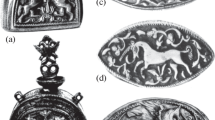Abstract
The design and construction of the decorative bell capital of the 1,600 year old Delhi iron pillar attests to the high degree of skill of the ancient Indian blacksmiths in working iron. Detailed visual observations clearly establish that the decorative bell capital is not a single piece of metal, but is composed of separate pieces that have been individually constructed by forge welding. A critical analysis of the fitting methodology of the Delhi iron pillar’s decorative top indicates that the individual pieces were fit around a cylindrical hollow iron shaft, which was connected to the main body of the pillar by means of an insert.
Similar content being viewed by others
References
J.C. Hudson, “The Delhi Iron Pillar,” Nature, 172 (1953), pp. 499–500.
G. Wranglen, “The Rustless Iron Pillar at Delhi,” Corrosion Science, 10 (1970), pp. 761–770.
W.E. Bardgett and J.F. Stanners, “The Delhi Iron Pillar—A Study of the Corrosion Aspects,” J. Iron and Steel Inst., 210 (1963), pp. 3–10; NML Technical J., 5 (1963), pp. 24–30.
R. Hadfield, “Discussion on Friend and Thorneycraft’s paper on Ancient Iron,” J. Iron and Steel Inst., 112 (1925), pp. 233–235.
M.K. Ghosh, “The Delhi Iron Pillar and Its Iron,” NML Technical J., 5 (1963), pp. 31–45.
R. Balasubramaniam, “Mixed Potential Theory Analysis of the Corrosion Resistance of the Delhi Iron Pillar,” Trans. Indian. Inst. Metals 50 (1997), pp. 23–35.
R. Balasubramaniam, “Studies on the Corrosion Resistance of Delhi Iron Pillar,” NML Technical J., 37 (1995) pp. 123–142.
W. Rosenhain, Physical Metallurgy (London: Constable, 1915), pp. 329.
A. Herrero and M. de Zubiria, “The Phenomenon of Corrosion of Iron and Steel,” J. Iron and Steel Inst., 118 (1928), pp. 109–125.
Y.D. Beglar, Archeological Survey of India Annual Reports, IV (1871/72) pp. 28–30.
R. Balasubramaniam, “New Insights on the Corrosion of the Delhi Iron Pillar Based on Historical and Dimensional Analysis,” Current Science, 73 (1997), pp. 1057–1067.
R. Balasubramaniam, “Elucidation of the Manufacturing Technology Employed to Construct the Main Body of the Delhi Iron Pillar,” to be published.
B. Prakash, “Metallurgy of Iron and Steel Making and Blacksmithy in Ancient India,” Ind. J. Hist. Sci., 26 (1991), pp. 351–371.
B. Prakash and V. Tripathi, “Iron Technology in Ancient India,” Metals and Materials, 2 (1986), pp. 568–579.
R.K. Dube, “Aspects of Powder Technology in Ancient and Medieval India,” Powder Metallurgy, 33 (1990), pp. 119–125.
R. Hadfield, “Sinhalese Iron and Steel of Ancient Origin,” J. Iron and Steel Inst., 85 (1912), pp. 134–174.
K.N.P. Rao, “Delhi Iron Pillar,” Metal News, 13 (1991), pp. 9–15.
P. Brown, Indian Architecture (Buddhist and Hindu Periods), seventh reprint (Bombay: D.P. Taraporevala and Sons, 1976), pp. 11–49.
R.S. Tripathi, History of Ancient India (New Delhi: Motilal Banarsidass Publishers, 1992), pp. 252–253.
A.K. Biswas, Minerals and Metals in Ancient India, vol. I (New Delhi: D.K. Printworld, 1996).
T.R. Anantharaman, The Rustless Wonder—A Study of the Delhi Iron Pillar (New Delhi: Vigyan Prasar, 1997).
R. Balasubramaniam, “On the Presence of Lead in the Dehli Iron Pillar,” Bull. of Metals Museum, JIM, 29 (1998), in press.
Author information
Authors and Affiliations
Additional information
Author’s Note: According to the Gupta period Sulba Sutras (a compendium of rules concerning measurements), the ancient Indian measure of length, omitting microscopic measurements, was the angulam, which measured one inch. This was divided into eight yavas. For greater lengths, 12 angulas equaled one vitasti (12 inches or one foot), and two vitastis equaled one hasta or aratni. Further, four hastas resulted in one danda. In this article, the ancient Indian length measures are used in the figures. For ease of reading, U.S. standard measurements are used in the text.
R. Balasubramaniam is an associate professor in the Department of Materials and Metallurgical Engineering at the Indian Institute of Technology.
Rights and permissions
About this article
Cite this article
Balasubramaniam, R. The decorative bell capital of the Delhi iron pillar. JOM 50, 40–47 (1998). https://doi.org/10.1007/s11837-998-0378-3
Issue Date:
DOI: https://doi.org/10.1007/s11837-998-0378-3




